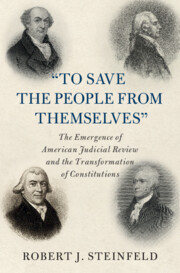 'To Save the People from Themselves'
'To Save the People from Themselves' Book contents
- “To Save the People from Themselves”
- Cambridge Historical Studies in American Law and Society
- “To Save the People from Themselves”
- Copyright page
- Dedication
- Contents
- Acknowledgments
- Introduction
- Part One Legislatures and Legislation under the First American Constitutions
- 1 The Largely “Legislative” Character of the (“Horizontal” and “Vertical”) Constitutional Checks Placed on Colonial Legislatures
- 2 The Traditional Nature of the First Written Constitutions and the Role of Legislatures as Their Primary Expounders
- 3 Restoring “Legislative” Review of the Laws: The New York Constitution of 1777
- Part Two The Emergence of American Judicial Review: 1779–1787
- Part Three Judicial Review at the Federal Convention
- Index
2 - The Traditional Nature of the First Written Constitutions and the Role of Legislatures as Their Primary Expounders
from Part One - Legislatures and Legislation under the First American Constitutions
Published online by Cambridge University Press: 17 September 2021
- “To Save the People from Themselves”
- Cambridge Historical Studies in American Law and Society
- “To Save the People from Themselves”
- Copyright page
- Dedication
- Contents
- Acknowledgments
- Introduction
- Part One Legislatures and Legislation under the First American Constitutions
- 1 The Largely “Legislative” Character of the (“Horizontal” and “Vertical”) Constitutional Checks Placed on Colonial Legislatures
- 2 The Traditional Nature of the First Written Constitutions and the Role of Legislatures as Their Primary Expounders
- 3 Restoring “Legislative” Review of the Laws: The New York Constitution of 1777
- Part Two The Emergence of American Judicial Review: 1779–1787
- Part Three Judicial Review at the Federal Convention
- Index
Summary
The framers of the first state constitutions established a system in which the representatives of the people, embodied in their legislatures, were to be supreme within governments. With only two partial exceptions, the early constitutions imposed no formal check on the power of legislatures to make law. But these representative bodies were not, for the most part, regarded as sovereign. Rather, most Americans believed that the sovereign people themselves would supervise the conduct of their representatives.1 Constitutional restrictions would be enforced against legislatures “politically” through a variety of forms of popular action, but most especially by means of the frequent (annual) elections almost all the first constitutions required for their lower houses. Legislatures would be held to constitutional standards as popular opinion interpreted those. Under this system, the people would be entirely free to enact (through their legislatures) the laws by which they wished to govern themselves. Whenever they came to believe that their legislators had overstepped constitutional bounds in passing a particular statute, they possessed the plenary power to replace them with representatives who would more faithfully adhere to constitutional standards, and repeal offending legislation.
- Type
- Chapter
- Information
- 'To Save the People from Themselves'The Emergence of American Judicial Review and the Transformation of Constitutions, pp. 72 - 121Publisher: Cambridge University PressPrint publication year: 2021
